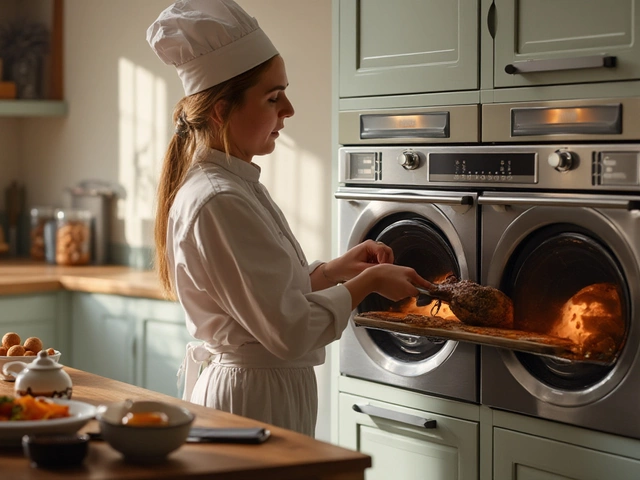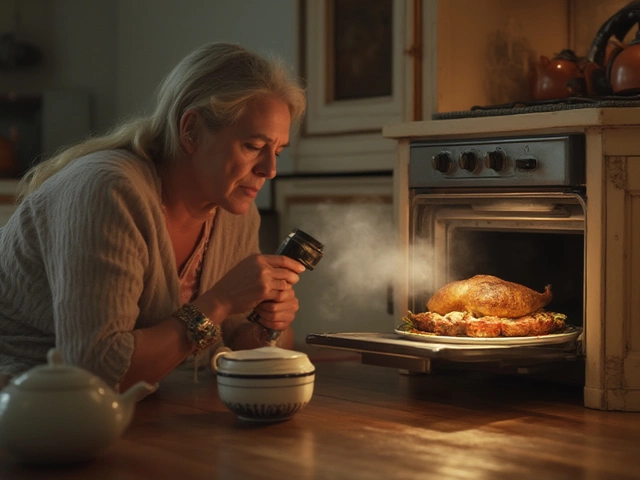You’re staring at your 8-year-old oven, wondering: “Should I fix this thing, or is it time to just let it go?” Honestly, you’re not alone. Electric ovens are one of those appliances nobody thinks about until something sizzles, sparks, or just won’t heat up at all.
Here’s the deal—eight years used to feel old for an oven, but these days, with regular use and a bit of care, a good electric oven can sometimes grind out a few more reliable years. But, as they get older, repair costs can sneak up quick, and you have to weigh if it’s really worth dumping money into an aging appliance. Let’s break down the math, check for common issues that pop up around this age, and talk about what you can actually fix yourself without risking a fire or a giant headache. All the while, you want to keep your kitchen running and your wallet happy.
- How Long Do Electric Ovens Really Last?
- Common Problems After 8 Years
- Comparing Repair Costs vs. Replacement
- When to Tackle Oven Fixes Yourself
- Warning Signs It’s Time to Move On
- Tips for Getting the Most from Your Oven
How Long Do Electric Ovens Really Last?
On average, an electric oven runs strong for about 13 to 15 years if you stick to the basics like cleaning spills, keeping the door seal in decent shape, and not slamming the door shut. Most brands—think GE, Whirlpool, Bosch—fall into this same ballpark. But here’s the kicker: if your oven’s made it past 8 years without major problems, you’re already ahead of what some call the "appliance curse" where things start acting up right after the warranty fades.
A 2022 survey from a major consumer products group found that over half of people with ovens over 10 years old hadn’t needed a major fix yet. The other half? They usually dealt with things like busted heating elements or dead thermostats. So, lifespan isn’t just about age—it’s how much you cook, if the oven sees a lot of baking or roasting, and if it’s working overtime during the holidays.
Something else to think about is the model and brand. Some ovens have parts that cost a lot or are hard to find after a few years, especially if the brand doesn’t keep up on support. If your oven is a well-known brand, chances are you’ll have an easier (and cheaper) time if repairs do pop up.
Lastly, energy use changes as an electric oven gets older. Older models get a bit less efficient, so you may see your bills creep up. If energy savings are important, or you notice your oven heating slower than it used to, that’s another sign your appliance has some age.
The bottom line? If your electric oven is still working reliably at 8 years, you could have several good years left—but parts, repair hassle, and energy bills start to matter more as you keep going.
Common Problems After 8 Years
By the 8-year mark, most electric ovens have seen their fair share of casseroles, cookies, and pizza nights. That much action isn’t kind to every part of the oven, and certain issues start to show up more often right around this time.
Heating problems top the list. Maybe the oven isn’t getting hot enough or its temps are all over the place. Nine times out of ten, it’s a busted heating element or a laggy temperature sensor. When your oven starts baking slower than it should, there’s a good chance one of those two is to blame.
Broken door seals are another annoying thing. After years of opening, closing, and the occasional slam, the rubber gasket loosens or cracks. That lets heat escape, so your energy bill creeps up and food takes forever—or cooks unevenly.
Then there’s the control panel. Sometimes the touchpad gets unresponsive, or buttons stick. Control boards can actually start failing after about 6-10 years, especially if you bake a lot or if steam found its way behind the buttons. If you’re seeing flashing error codes that never used to appear, this might be what’s going on.
Let’s not ignore burners or internal fans. On combo ovens, the convection fan might get noisy, slow, or just quit. Same with the light inside. Burned-out bulbs are nothing, but if you keep changing them and they keep going out, it could hint at a wiring issue deeper inside.
- Uneven heating or not heating at all
- Visible damage or wear on the door gasket
- Control panel glitches, stuck buttons, or random error codes
- Loud or inoperative convection fans
- Blown interior bulbs or flickering lights
Check out this quick breakdown of common electric oven breakdowns after 8 years:
| Problem | Most Likely Cause | Average Repair Cost (USD) |
|---|---|---|
| Temperature issues | Heating element or sensor | $120–$250 |
| Door not sealing | Damaged gasket | $60–$120 |
| Control panel won’t respond | Faulty control board | $200–$350 |
| Noisy/faulty fan | Worn fan motor | $100–$200 |
| Frequent bulb burnout | Electrical issue | $80–$150 |
You might be thinking, “Are these fixes really worth it?” Here’s where the question gets real: if your oven’s got a few minor issues and hasn’t needed repairs until now, fixing it could be a smart move. But once you pile up two or three of these problems at once, the cost quickly catches up with the price of a new appliance. And keep in mind, the oven repair market doesn’t always guarantee original parts for older models, which can also slow things down or boost costs even further.
Comparing Repair Costs vs. Replacement
This is the section where your wallet’s either going to take a sigh of relief, or brace for impact. Repairing an 8-year-old oven repair can be a mixed bag, depending on the problem, the brand, and parts access. Simple fixes—like a busted bake element or a bad thermostat—cost way less than a new oven, but bigger issues can add up quick.
Check this out—here’s what you’re likely to spend, based on 2025 appliance repair rates:
| Part/Repair | Typical Repair Cost (USD) |
|---|---|
| Bake Element Replacement | $120–$250 |
| Control Panel/Board | $200–$450 |
| Thermostat | $150–$300 |
| Door Seal/Gasket | $80–$150 |
| Heating Element (Broil) | $100–$225 |
Now, compare that to the price of a decent new electric oven—right now, you’re usually looking at $650–$1,400 for a standard model. Premium or smart ovens? Try $2,000 or beyond. That’s not even counting delivery and installation, which can tack on another $100 or more, especially if your power hookup needs an upgrade.
Here’s a quick trick: If the repair will cost you more than half the price of a new oven, most appliance folks say it’s smarter to replace. So, let’s say your control board fries and the quote is $400, but a basic new unit is $800—at that point, replacement makes way more sense.
- Factor in invisible costs like time waiting for parts, or extra charges if your oven’s an older or less common model.
- If you DIY, you’ll save labor charges, but watch for warranty issues—you might void it if you go rogue on repairs.
Bottom line: Run the real numbers before you call in the pros or start shopping for that shiny new oven. Sometimes the answer is clearer than you think.

When to Tackle Oven Fixes Yourself
Not every oven breakdown is a death sentence. Some issues are so simple, you can fix them with stuff you already have in your junk drawer or toolbox. Before picking up the phone or throwing money at a repair, check out these common problems you can often handle on your own. This can save you both time and cash, especially with an oven repair bill running anywhere from $100 to $400, and that's if you skip the after-hours fees.
- No Power? First, check if the oven is plugged in properly. Sounds obvious, but loose cords or a tripped breaker are classic culprits. Try flipping your kitchen circuit breaker off and back on. If the oven lights up, you just dodged a bill.
- Wonky Oven Door: Sometimes, the door won't close tight because of worn hinges or a dirty seal. Grab a flashlight and look for food gunk or bent parts. If it's the seal, you can buy a replacement gasket online and install it in minutes following the included instructions.
- The Oven Doesn’t Heat Up: If the oven stays cold but the lights and controls work, the bake or broil element might be done for. Unplug the oven, pop out the screws, and look for visible breaks or burn marks. Replacements for common brands like GE and Whirlpool are easy to find online. Just match the model number; swapping the part is usually plug-and-play.
- Control Panel Glitches: Resetting the main control board is sometimes all it takes. Unplug the oven for a few minutes, then power it back on. If the screen or buttons work, you're good. If not, it may be time for professional help.
Of course, don’t risk your safety. Stay far away from anything that smells like burning wires or involves gas lines. And if you’re ever unsure, there’s zero shame in calling a pro. But for simple things—power checks, door fixes, and easy part swaps—you can totally handle these without busting your budget.
Warning Signs It’s Time to Move On
Some signs scream, "Enough is enough!" when it comes to your old oven. It might feel like keeping an old friend around, but when the headaches add up, you’ve got to ask yourself if it’s actually smart—or just stubbornness.
- Electric oven takes forever to heat up. If preheating feels like a whole episode of your favorite show, something’s off. Old heating elements can get sluggish, but if it drags no matter what, the fix could cost as much as a new model.
- Uneven cooking gets worse. Maybe you used to have a single cool spot—now everything is unpredictable. If food burns in one spot and stays raw in another, replacing major internal parts (like the temperature sensor or convection fan) can be pricey and isn’t always worth it for an 8-year-old oven.
- Repairs are adding up. Oven repair isn’t cheap. If you’re calling the repair shop every few months or dropping over $200 a visit, that pattern tends to keep going. With average labor rates around $100-$150 an hour, it doesn’t take long before you’re way past the value of the oven.
- Replacement parts are hard to get. Manufacturers usually support appliances for about 7-10 years. Once your oven turns 8, parts might get discontinued or take weeks to find. If every fix is a wild goose chase, it’s not worth your stress.
- Big safety issues. Strange smells, electrical buzzing, or tripped breakers are danger signs. If you spot smoke, sparks, or melting plastic, that’s not something to gamble on. Electrical problems are a top reason to say goodbye fast.
- Energy bills creep up. As ovens wear down, they lose efficiency. If your utility bill jumps when you bake, it could be the oven draining extra juice every time you turn it on.
| Repair Type | Average Cost (USD) |
|---|---|
| Heating Element | $180 |
| Door Seal/Gasket | $90 |
| Temperature Sensor | $135 |
| Main Control Board | $300+ |
| Full Oven Replacement | $700 – $1400 |
If most of these issues line up with what you’re seeing, it’s usually smarter (and less stressful) to let go. Sometimes, tossing money at an old appliance is like patching holes in a leaky bucket—the water keeps running out, no matter how hard you try.
Tips for Getting the Most from Your Oven
If your oven’s hitting that eight-year mark, you want every last bit of value from it before thinking about a replacement. Even old electric ovens can hang in there with some basic care. Let’s talk about what actually makes a difference.
- Clean regularly: Grease and crumbs zap efficiency. A quick wipe down after use (once it’s cool!) and a deeper clean every couple months keeps heating elements working better.
- Check the door seal: If your oven door isn’t sealing tight, a lot of heat leaks out. This means longer cook times and higher electric bills. Rub your hand around the closed door while it’s on (carefully). If you feel heat escaping, swap out the gasket. They’re cheap and easier to replace than you might think.
- Don’t overload: Too many trays block air. Stick with recommended rack positions, and don’t jam the oven full—you’ll get more even cooking and reduce stress on the elements.
- Use oven thermometers: After several years, oven thermostats get cranky and start drifting off temp. Pick up a $10 oven thermometer, pop it inside, and see how far off your oven really is. Compensate by adjusting your cooking temps or get the thermostat recalibrated (most ovens let you do this yourself with a quick button combo in the manual).
- Replace worn out burners or elements: If you notice cold spots or food taking forever to cook, a heating element might be dying. These usually cost $20–$50 and plug right in. No need to call a pro unless it’s a really old or unusual model.
Keeping up with these basics actually helps save on electricity because your oven runs more efficiently—nothing fancy, just smart use. For perspective on where you stand, here’s a quick breakdown of average oven ages at the time people replace versus repair:
| Oven Age (Years) | Repair Rate (%) | Replacement Rate (%) |
|---|---|---|
| 5–7 | 65 | 35 |
| 8–10 | 50 | 50 |
| 11–15 | 30 | 70 |
So right at eight years, you’re in that fifty-fifty zone. Getting the most from your appliance now is mostly about regular upkeep and a little troubleshooting. That way, if you do decide to fix something big, at least you know you squeezed every cent of value out of your oven repair budget.




